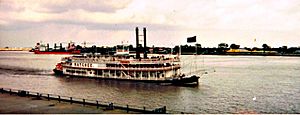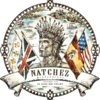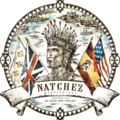Natchez, Mississippi facts for kids
Quick facts for kids
Natchez, Mississippi
|
|||
|---|---|---|---|

Pearl Street, Natchez
|
|||
|
|||
| Nickname(s):
The Bluff City, The Trace City, The River City, Antebellum Capital of the World, Historic Natchez on the Mississippi
|
|||
| Motto(s):
"On the Mighty Mississippi"
|
|||

Location of Natchez in Adams County
|
|||
| Country | United States | ||
| State | Mississippi | ||
| County | Adams | ||
| Founded | 1716 as Fort Rosalie, renamed Fort Panmure in 1763 Louisiana (New France) |
||
| Established | c. 1790 as the capital of the Natchez District Spanish West Florida |
||
| Incorporated | March 10, 1803 | ||
| Area | |||
| • City | 16.41 sq mi (42.49 km2) | ||
| • Land | 15.81 sq mi (40.96 km2) | ||
| • Water | 0.59 sq mi (1.53 km2) | ||
| Elevation | 217 ft (66 m) | ||
| Population
(2020)
|
|||
| • City | 14,520 | ||
| • Estimate
(2022)
|
13,812 | ||
| • Density | 918.12/sq mi (354.48/km2) | ||
| • Urban | 25,902 | ||
| • Metro | 53,611 (US: 200th) | ||
| Time zone | UTC-6 (Central (CST)) | ||
| • Summer (DST) | UTC-5 (CDT) | ||
| ZIP codes |
39120-39122
|
||
| Area code(s) | 601 | ||
| FIPS code | 28-50440 | ||
| GNIS feature ID | 0691586 | ||
Natchez (pronounced NATCH-iz) is a city in Adams County, Mississippi, United States. It is the only city in the county and also its county seat, which means it's the main town for local government. In 2020, about 14,520 people lived there.
Natchez is located right on the Mississippi River, across from Vidalia, Louisiana. It was a very important city before the American Civil War, known for its large cotton farms and busy river trade. The city is about 90 miles (145 km) southwest of Jackson, Mississippi, the state capital. It's also about 85 miles (137 km) north of Baton Rouge, Louisiana. Natchez is the 28th largest city in Mississippi. The city got its name from the Natchez people, a Native American group who lived in this area for many centuries.
Contents
History of Natchez
Natchez was started by French colonists in 1716. This makes it one of the oldest and most important European settlements in the lower Mississippi River Valley.
Early European Settlements
After the French lost the French and Indian War in 1763, they gave Natchez to Great Britain. The British government gave land in this area to officers who fought well in the war. These officers came mostly from New York, New Jersey, and Pennsylvania. They started large farms called plantations and brought their fancy way of life to the area.
In 1779, the area came under Spanish rule. After the American Revolutionary War, Great Britain gave the territory to the United States in 1783. However, Spain had taken Natchez from the British and didn't want to give it up.
In 1797, Major Andrew Ellicott of the United States claimed Natchez for the U.S. He raised the first American Flag there. This meant Natchez and other lands east of the Mississippi River became part of the United States.
Natchez as a Capital City
After the U.S. took control, Natchez became the capital of the Mississippi Territory. Later, it was the capital of the state of Mississippi. Natchez is much older than Jackson. Jackson became the new capital in 1822 because it was more in the center of the growing state.
Natchez was in a great spot on a high bluff overlooking the Mississippi River. This made it a key place for trade and for different cultures to meet. Native American, European, and African cultures mixed here for two centuries.
The Natchez Trace and Trade
In the early 1800s, Natchez was important for the Old Southwest region. It was the southern end of the historic Natchez Trace. The northern end was in Nashville, Tennessee. After unloading their goods in Natchez or New Orleans, many boat crews would walk the Trace back home. This was because traveling north on the Mississippi River was very hard until steam-powered vessels were invented in the 1820s. The Natchez Trace was also important during the War of 1812. Today, the modern Natchez Trace Parkway still ends in Natchez.

Slavery and Plantations
Before the Civil War, Natchez was a major city for the trade of enslaved people in Mississippi. It was second only to New Orleans in the United States. The main markets were at a place called the Forks of the Road.
Wealthy plantation owners lived in Natchez and built grand mansions. Their plantations were huge areas of land along the river. There, they grew large amounts of cotton and sugarcane using slave labor. Natchez was the main port for sending these crops to Northern cities and to New Orleans. From New Orleans, many goods were sent to Europe. Many of these beautiful mansions built before 1860 still stand today. They are a big part of the city's look and history. Farming was the main way people made money in the area until the 1900s.
The Great Natchez Tornado
In 1840, a terrible tornado hit Natchez. It killed 317 people and hurt 109. This tornado is still one of the deadliest in U.S. history.
The Civil War and After
During the American Civil War, Natchez was given up by Confederate forces without a fight in September 1862. After the Union won the Battle of Vicksburg in July 1863, many people, including formerly enslaved people, moved to Natchez. The Union Army set up a refugee camp in a natural pit called the Devil's Punchbowl. Many people in this camp faced difficult conditions.
After the Civil War, Natchez quickly recovered. This was because the city was not destroyed like many other places in the South. From 1870 to 1871, Robert H. Wood served as Mayor of Natchez. He was one of the first African American mayors in the entire country. Natchez was also home to other important African American politicians like Hiram Rhodes Revels and John R. Lynch.
Twentieth Century Changes
In the 1900s, Natchez's economy slowed down. Steamboat travel on the Mississippi River was replaced by railroads, which sometimes bypassed the river cities. Later, many local businesses closed, leading to fewer jobs. Even though Natchez is a popular place for heritage tourism because of its old buildings, its population has gone down since 1960. It is still the main city of the Natchez micropolitan area.
Geography and Climate
Natchez covers about 13.9 square miles (36 km²). Most of this is land, with a small part being water.
Climate in Natchez
Natchez has a humid subtropical climate. This means it has hot, humid summers and mild winters.
| Climate data for Natchez, Mississippi (1991–2020 normals, extremes 1892–present) | |||||||||||||
|---|---|---|---|---|---|---|---|---|---|---|---|---|---|
| Month | Jan | Feb | Mar | Apr | May | Jun | Jul | Aug | Sep | Oct | Nov | Dec | Year |
| Record high °F (°C) | 83 (28) |
86 (30) |
92 (33) |
92 (33) |
99 (37) |
103 (39) |
105 (41) |
105 (41) |
105 (41) |
98 (37) |
89 (32) |
89 (32) |
105 (41) |
| Mean daily maximum °F (°C) | 56.9 (13.8) |
60.9 (16.1) |
68.0 (20.0) |
75.1 (23.9) |
81.7 (27.6) |
87.3 (30.7) |
89.5 (31.9) |
89.3 (31.8) |
85.5 (29.7) |
76.9 (24.9) |
66.6 (19.2) |
58.9 (14.9) |
74.7 (23.7) |
| Daily mean °F (°C) | 46.4 (8.0) |
50.0 (10.0) |
57.3 (14.1) |
63.9 (17.7) |
71.7 (22.1) |
77.9 (25.5) |
80.4 (26.9) |
79.9 (26.6) |
75.1 (23.9) |
65.1 (18.4) |
54.8 (12.7) |
48.4 (9.1) |
64.2 (17.9) |
| Mean daily minimum °F (°C) | 35.9 (2.2) |
39.0 (3.9) |
46.5 (8.1) |
52.7 (11.5) |
61.6 (16.4) |
68.5 (20.3) |
71.3 (21.8) |
70.5 (21.4) |
64.7 (18.2) |
53.2 (11.8) |
43.0 (6.1) |
37.9 (3.3) |
53.7 (12.1) |
| Record low °F (°C) | 4 (−16) |
4 (−16) |
18 (−8) |
28 (−2) |
30 (−1) |
49 (9) |
55 (13) |
50 (10) |
40 (4) |
27 (−3) |
18 (−8) |
5 (−15) |
4 (−16) |
| Average precipitation inches (mm) | 6.23 (158) |
5.54 (141) |
6.03 (153) |
4.90 (124) |
4.69 (119) |
4.48 (114) |
4.47 (114) |
4.87 (124) |
4.14 (105) |
4.04 (103) |
5.08 (129) |
5.66 (144) |
60.13 (1,527) |
| Average snowfall inches (cm) | 0.1 (0.25) |
0.0 (0.0) |
0.0 (0.0) |
0.0 (0.0) |
0.0 (0.0) |
0.0 (0.0) |
0.0 (0.0) |
0.0 (0.0) |
0.0 (0.0) |
0.0 (0.0) |
0.0 (0.0) |
0.2 (0.51) |
0.3 (0.76) |
| Average precipitation days (≥ 0.01 in) | 11.2 | 10.4 | 9.9 | 8.3 | 9.2 | 9.9 | 10.6 | 10.2 | 7.2 | 6.7 | 7.8 | 10.3 | 111.7 |
| Average snowy days (≥ 0.1 in) | 0.1 | 0.0 | 0.0 | 0.0 | 0.0 | 0.0 | 0.0 | 0.0 | 0.0 | 0.0 | 0.0 | 0.0 | 0.1 |
| Source: NOAA | |||||||||||||
People of Natchez
| Historical population | |||
|---|---|---|---|
| Census | Pop. | %± | |
| 1810 | 1,511 | — | |
| 1820 | 2,184 | 44.5% | |
| 1830 | 2,789 | 27.7% | |
| 1840 | 3,612 | 29.5% | |
| 1850 | 4,434 | 22.8% | |
| 1860 | 6,612 | 49.1% | |
| 1870 | 9,057 | 37.0% | |
| 1880 | 7,058 | −22.1% | |
| 1890 | 10,101 | 43.1% | |
| 1900 | 12,210 | 20.9% | |
| 1910 | 11,791 | −3.4% | |
| 1920 | 12,608 | 6.9% | |
| 1930 | 13,422 | 6.5% | |
| 1940 | 15,296 | 14.0% | |
| 1950 | 22,740 | 48.7% | |
| 1960 | 23,791 | 4.6% | |
| 1970 | 19,704 | −17.2% | |
| 1980 | 22,015 | 11.7% | |
| 1990 | 19,535 | −11.3% | |
| 2000 | 18,464 | −5.5% | |
| 2010 | 15,792 | −14.5% | |
| 2020 | 14,520 | −8.1% | |
| 2022 (est.) | 13,812 | −12.5% | |
| U.S. Decennial Census 2020 Census |
|||
Population and Diversity
In 2020, Natchez had 14,520 people living in 6,028 homes. The city is home to a diverse population.
| Race | Num. | Perc. |
|---|---|---|
| Black or African American | 8,729 | 60.12% |
| White | 5,156 | 35.51% |
| Native American | 16 | 0.11% |
| Asian | 73 | 0.5% |
| Pacific Islander | 2 | 0.01% |
| Other/Mixed | 343 | 2.36% |
| Hispanic or Latino | 201 | 1.38% |
Education in Natchez
Natchez offers several options for learning, from colleges to public and private schools.
Higher Education
- Alcorn State University has a campus in Natchez. It offers programs in nursing and business, including a Master of Business Administration (MBA) degree. These programs help students get important skills for jobs in Southwest Mississippi.
- Copiah-Lincoln Community College also has a campus in Natchez.
Local Schools
The city of Natchez and Adams County share one public school system, the Natchez-Adams School District. It has ten schools, including:
- Susie B. West
- Morgantown
- Gilmer McLaurin
- Joseph F. Frazier
- Robert Lewis Magnet School
- Natchez Freshman Academy
- Natchez Early College@Co-Lin
- Central Alternative School
- Natchez High School
- Fallin Career and Technology Center
Natchez also has private and religious schools:
- Adams County Christian School (ACCS) is a school for grades PK-12.
- Cathedral School is also a PK-12 school. It is connected to the Roman Catholic St. Mary Basilica.
- Holy Family Catholic School, started in 1890, is a PK-3 school linked to Holy Family Catholic Church.
Media and Transportation
Natchez has its own newspaper, radio stations, and is part of larger TV markets. The city is also connected by several highways, a railway, and an airport.
Local Media
- Newspaper: The Natchez Democrat
- Radio:
- Television: Natchez is covered by TV stations from Alexandria, Louisiana, and Jackson, Mississippi.
Getting Around Natchez
- Highways:
- U.S. 61 goes north and south, following the Mississippi River.
- U.S. 84 goes east and west, crossing the Mississippi River.
- U.S. 425 goes north from Natchez after crossing the Mississippi.
- U.S. 98 goes east from Natchez.
- Mississippi 555 and Mississippi 554 are local highways.
- Rail: The Natchez Railway serves the city.
- Air: The Natchez-Adams County Airport is for general aviation. For commercial flights, the closest airports are Baton Rouge Metropolitan Airport and Alexandria International Airport.
Famous People from Natchez
- Robert H. Adams: A former U.S. Senator from Mississippi.
- William Wirt Adams: A Confederate Army officer who grew up in Natchez.
- Glen Ballard: A five-time Grammy Award-winning songwriter and producer.
- Campbell Brown: An Emmy Award-winning journalist for CNN.
- Olu Dara: A musician and the father of rapper Nas.
- Varina Howell Davis: The first lady of the Confederate States of America; she was born and grew up in Natchez.
- Bob Dearing: A long-time member of the Mississippi State Senate.
- Ellen Douglas: A novelist.
- Stephen Duncan: A planter and banker.
- Jimmie Giles: An NFL Tight End and four-time Pro Bowl player.
- Mickey Gilley: A country music singer.
- Hugh Green: A famous college and professional football player.
- Elizabeth Taylor Greenfield: A noted Black concert singer.
- Cedric Griffin: A former NFL cornerback.
- Bishop Gunn: A rock and roll band whose members are from Natchez.
- Greg Iles: A best-selling author who sets many of his novels in Natchez.
- William Johnson: Known as "The Barber of Natchez," he was a freed slave and a successful businessman.
- John R. Lynch: The first African-American Speaker of the House in Mississippi and an early African-American member of Congress.
- Lynda Lee Mead: Miss America in 1960. A street in Natchez is named after her.
- Marion Montgomery: A jazz singer.
- Anne Moody: A civil rights activist and author.
- Alexander O'Neal: An R&B singer.
- John Anthony Quitman: A hero from the Mexican–American War and a former governor of Mississippi.
- Stevan Ridley: An NFL running back.
- Billy Shaw: A Pro Football Hall of Fame member.
- Chris Shivers: A two-time world champion bull rider.
- Abdul Rahman Ibrahima Sori: An African nobleman who was enslaved in Natchez before being freed.
- Hound Dog Taylor: A blues singer and slide guitar player.
- Richard Wright: A famous novelist, who lived in Natchez as a child.
- Robert H. Wood: A politician and the first African American mayor in the United States.
Historic Places to Visit
Natchez has many historic sites that tell its long story.
Ancient and Early Modern Sites
Antebellum Period Sites (Before the Civil War)
- Commercial Bank and Banker's House
- First Presbyterian Church of Natchez
- Natchez Museum of African American History and Culture
- Natchez National Cemetery
- Natchez On-Top-of-the-Hill Historic District
- Selma Plantation
- St. Mary Basilica, Natchez
- United States Courthouse (Natchez, Mississippi)
Historic Homes
Many beautiful homes built before the Civil War are still standing in Natchez.
- Airlie (Natchez)
- Arlington (Natchez, Mississippi)
- Auburn (Natchez, Mississippi)
- Brandon Hall (Washington, Mississippi)
- The Briars (Natchez, Mississippi)
- The Burn (Natchez, Mississippi)
- Concord (Natchez, Mississippi)
- Cottage Gardens
- D'Evereux
- Dunleith
- Elgin (Natchez, Mississippi)
- The Elms (Natchez, Mississippi)
- Elms Court
- Glenfield Plantation
- Gloucester (Natchez, Mississippi)
- Hawthorne Place
- Homewood Plantation (Natchez, Mississippi)
- Lansdowne (Natchez, Mississippi)
- Linden (Natchez, Mississippi)
- Longwood (Natchez, Mississippi)
- Magnolia Hill (Natchez, Mississippi)
- Melrose (Natchez, Mississippi)
- Monmouth (Natchez, Mississippi)
- Montaigne (Natchez, Mississippi)
- Ravenna (Natchez, Mississippi)
- Richmond (Natchez, Mississippi)
- Routhland
Town Houses
These are historic homes located within the city itself.
- Choctaw
- Green Leaves
- House on Ellicott's Hill
- King's Tavern
- The Presbyterian Manse
- Magnolia Hall (Natchez, Mississippi)
- Rosalie Mansion
- Smith-Bontura-Evans House
- Stanton Hall
- William Johnson House (Natchez, Mississippi)
- Winchester House (Natchez, Mississippi)
Images for kids
See also
 In Spanish: Natchez (Misisipi) para niños
In Spanish: Natchez (Misisipi) para niños







